Optimization of Ultrasonic Flavonoid Extraction from Saussurea involucrate, and the Ability of Flavonoids to Block Melanin Deposition in Human Melanocytes
Abstract
:1. Introduction
2. Results and Discussion
2.1. Optimization of the SIFs Extraction
2.2. Analyses of the Regression Coefficients and Variances
2.3. Analysis of the RSM
2.4. Validation of the Model
2.5. SIFs Extract Antioxidant Activities
2.6. The Effect of SIFs Extract on A375 Cell Activity
2.7. The effect of SIFs Extract on Antioxidant Enzymes Activities in A375 Cells
2.8. The Effect of SIFs Extract on Genes Related to the Melanin Synthesis Signaling Pathway
3. Materials and Methods
3.1. Material
3.2. Experimental Design
3.3. Determination of Total Flavonoid Content
3.4. Determination of Antioxidant Activities In Vitro
3.4.1. Determination of Reducing Power
3.4.2. Determination of DPPH Scavenging Activity
3.4.3. Determination of ABTS+ Scavenging Activity
3.4.4. Determination of Hydroxyl Radical Scavenging Activity
3.4.5. Determination of Superoxide Anion Scavenging Activity
3.5. Cell Experiment
3.5.1. Cell Culture
3.5.2. α-MSH Treatment
3.5.3. Intracellular Tyrosinase Activity
3.5.4. Melanin Content
3.5.5. Determination of Gene Expression by qRT-PCR
3.5.6. Detection of Superoxide Dismutase (SOD), Catalase (CAT) and Glutathione Peroxidase (GXP) Activities
4. Conclusions
Supplementary Materials
Author Contributions
Funding
Conflicts of Interest
Abbreviations
References
- Chik, W.I.; Zhu, L.; Fan, L.L.; Yi, T.; Zhu, G.Y.; Gou, X.J.; Tang, Y.N.; Xu, J.; Yeung, W.P.; Zhao, Z.Z.; et al. Saussurea involucrata: A review of the botany, phytochemistry and ethnopharmacology of a rare traditional herbal medicine. J. Ethnopharmacol. 2015, 172, 44–60. [Google Scholar] [CrossRef] [Green Version]
- Byambaragchaa, M.; Dela Cruz, J.F.; Yang, S.H.; Hwang, S.G. Anti-metastatic potential of ethanol extract of Saussurea involucrata against hepatic cancer in vitro. Asian Pac. J. Cancer Prev. 2013, 14, 5397–5402. [Google Scholar] [CrossRef] [PubMed]
- Yi, T.; Zhao, Z.Z.; Yu, Z.L.; Chen, H.B. Comparison of the anti-inflammatory and anti-nociceptive effects of three medicinal plants known as “Snow Lotus” herb in traditional Uighur and Tibetan medicines. J. Ethnopharmacol. 2010, 128, 405–411. [Google Scholar] [CrossRef] [PubMed] [Green Version]
- Qiu, J.; Xue, X.F.; Chen, F.D.; Li, C.H.; Bolat, N.; Wang, X.J.; Baima, Y.Z.; Zhao, Q.; Zhao, D.X.; Ma, F.S. Quality evaluation of snow lotus (Saussurea): Quantitative chemical analysis and antioxidant activity assessment. Plant Cell Rep. 2010, 29, 1325–1337. [Google Scholar] [CrossRef] [PubMed]
- Qiu, J.; Gao, F.H.; Shen, G.A.; Li, C.H.; Han, X.Y.; Zhao, Q.; Zhao, D.X.; Hua, X.J.; Pang, Y.Z. Metabolic engineering of the phenylpropanoid pathway enhances the antioxidant capacity of Saussurea involucrata. PLoS ONE 2013, 8, e70665. [Google Scholar] [CrossRef] [Green Version]
- Jia, J.M.; Wu, C.F. Antifatigue activity of tissue culture extracts of Saussurea involucrata. Pharm. Biol. 2008, 46, 433–436. [Google Scholar] [CrossRef] [Green Version]
- Dai, C.Y.; Liu, P.F.; Liao, P.R.; Qu, Y.; Wang, C.X.; Yang, Y.; Cui, X.M. Optimization of flavonoids extraction process in Panax notoginseng stem leaf and a study of antioxidant activity and its effects on mouse melanoma B16 Cells. Molecules 2018, 23, 2219. [Google Scholar] [CrossRef] [Green Version]
- Kudo, M.; Kobayashi-Nakamura, K.; Tsuji-Naito, K. Bifunctional effects of O-methylated flavones from Scutellaria baicalensis Georgi on melanocytes: Inhibition of melanin production and intracellular melanosome transport. PLoS ONE 2017, 12, e0171513. [Google Scholar] [CrossRef]
- Tsoi, B.; Yi, R.N.; Cao, L.F.; Li, S.B.; Tan, R.R.; Chen, M.; Li, X.X.; Wang, C.; Li, Y.F.; Hiroshi, K.; et al. Comparing antioxidant capacity of purine alkaloids: A new, efficient trio for screening and discovering potential antioxidants in vitro and in vivo. Food Chem. 2015, 176, 411–419. [Google Scholar] [CrossRef]
- Liu, C.H.; Qin, K.; Qi, Y.X.; Li, K.; Li, Y.Q.; Jia, B.X. Optimization of ultrasonic extraction of total flavonoids from Tussilago farfara L. using response surface methodology. Pharmazie 2014, 69, 311–315. [Google Scholar]
- Fan, T.; Hu, J.G.; Fu, L.D.; Zhang, L.J. Optimization of enzymolysis-ultrasonic assisted extraction of polysaccharides from Momordica charabtia L. by response surface methodology. Carbohydr. Polym. 2015, 115, 701–706. [Google Scholar] [CrossRef] [PubMed]
- Qiao, D.L.; Hu, B.; Gan, D.; Sun, Y.; Ye, H.; Zeng, X.X. Extraction optimized by using response surface methodology, purification and preliminary characterization of polysaccharides from Hyriopsis cumingii. Carbohydrate Polym. 2009, 76, 422–429. [Google Scholar] [CrossRef]
- Preece, D.; Montgomery, D. Design and Analysis of Experiments; Wiley: New York, NY, USA, 2008. [Google Scholar]
- Lee, H.V.; Yunus, R.; Juan, J.C.; Taufiq-Yap, Y.H. Process optimization design for jatropha-based biodiesel production using response surface methodology. Fuel Process Technol. 2011, 92, 2420–2428. [Google Scholar] [CrossRef] [Green Version]
- Draper, N.R.; Smith, H. Applied Regression Analysis; Wiley: New York, NY, USA, 1966; pp. 325–328. [Google Scholar]
- Noordin, M.Y.; Venkatesh, V.C.; Sharif, S.; Elting, S.; Abdullah, A. Application of response surface methodology in describing the performance of coated carbide tools when turning AISI 1045 steel. J. Mater. Process Technol. 2004, 145, 46–58. [Google Scholar] [CrossRef] [Green Version]
- Nguyen, H.X.; Nguyen, T.B.N.; Bae, W.; Dang, T.Q.C.; Chung, T. An approach for the prediction of optimum conditions for thesteam assisted gravity drainage process by response surface methodology. Energy Source Part-A 2014, 36, 1103–1114. [Google Scholar] [CrossRef]
- Jing, Z.; Zheng, X.X.; Yang, Q.; Liang, Z.Y.; Li, D.H.; Yang, X.B.; Xu, J. Optimization of ultrasonic-assisted extraction and radical-scavenging capacity of phenols and flavonoids from Clerodendrum cyrtophyllum Turcz leaves. PLoS ONE 2013, 8, e68392. [Google Scholar]
- Wang, X.; Wu, Q.; Wu, Y.; Chen, G.; Yue, W.; Liang, Q. Response surface optimized ultrasonic-assisted extraction of flavonoids from Sparganii rhizoma and evaluation of their in vitro antioxidant activities. Molecules 2012, 17, 6769–6783. [Google Scholar] [CrossRef]
- Gao, F.; Zheng, L.L.; Wang, D.; Li, Y.Y.; Peng, H.Y.; Yuan, M.Y. Ultrasound-assisted extraction of total flavonoids from aconitum gymnandrum. Pharmacognosy Mag. 2014, 10, 141–146. [Google Scholar] [CrossRef] [Green Version]
- Lee, M.H.; Lin, C.C. Comparison of techniques for extraction of isoflavones from the root of Radix Puerariae: Ultrasonic and pressurized solvent extractions. Food Chem. 2007, 105, 223–228. [Google Scholar] [CrossRef]
- Gulcin, I. Comparison of in vitro antioxidant and antiradical activities of L-tyrosine and L-Dopa. Amino Acids 2007, 32, 431–438. [Google Scholar] [CrossRef]
- Arung, E.T.; Shimizu, K.; Tanaka, H.; Kondo, R. 3-Prenyl luteolin, a new prenylated flavone with melanin biosynthesis inhibitory activity from wood of Artocarpus heterophyllus. Fitoterapia 2010, 81, 640–643. [Google Scholar] [CrossRef] [PubMed]
- Promden, W.; Viriyabancha, W.; Monthakantirat, O.; Umehara, K.; Noguchi, H.; de-Eknamkul, W. Correlation between the potency of flavonoids on mushroom tyrosinase inhibitory activity and melanin synthesis in melanocytes. Molecules 2018, 23, 1403. [Google Scholar] [CrossRef] [PubMed] [Green Version]
- Panich, U.; Onkoksoong, T.; Limsaengurai, S.; Akarasereenont, P.; Wongkajornsilp, A. UVA-induced melanogenesis and modulation of glutathione redox system in different melanoma cell lines: The protective effect of gallic acid. J. Photochem. Photobiol.-B 2012, 108, 16–22. [Google Scholar] [CrossRef] [PubMed]
- Wrzesniok, D.; Beberok, A.; Otreba, M.; Buszman, E. Modulation of melanogenesis and antioxidant defense system in melanocytes by amikacin. Toxicol. In Vitro 2013, 27, 1102–1108. [Google Scholar] [CrossRef]
- Busca, R.; Ballotti, R. Cyclic AMP a key messenger in the regulation of skin pigmentation. Pigment. Cell Res. 2000, 13, 60–69. [Google Scholar] [CrossRef]
- Goding, C.R. Mitf from neural crest to melanoma: Signal transduction and transcription in the melanocyte lineage. Genes Dev. 2000, 14, 1712–1728. [Google Scholar]
- Vance, K.W.; Goding, C.R. The transcription network regulating melanocyte development and melanoma. Pigment. Cell Res. 2004, 17, 318–325. [Google Scholar] [CrossRef]
- Chou, T.H.; Ding, H.Y.; Hung, W.J.; Liang, C.H. Antioxidative characteristics and inhibition of alpha-melanocyte-stimulating hormone-stimulated melanogenesis of vanillin and vanillic acid from Origanum vulgare. Exp. Dermatol. 2010, 19, 742–750. [Google Scholar] [CrossRef]
- Ren, X.Y.; He, L.; Cheng, J.W.; Chang, J.M. Optimization of the solid-state fermentation and properties of a polysaccharide from Paecilomyces cicadae (Miquel) Samson and its antioxidant activities in vitro. PLoS ONE 2014, 9, e87578. [Google Scholar] [CrossRef]
- Jia, Z.S.; Tang, M.C.; Wu, J.M. The determination of flavonoid content in mulberry and their scavenging effects on superoxide radicals. Food Chem. 1999, 64, 555–559. [Google Scholar]
- Sun, Y.X.; Liu, J.C.; Kennedy, J.F. Extraction optimization of antioxidant polysaccharides from the fruiting bodies of Chroogomphis rutilus (Schaeff.: Fr.) O.K. Miller by Box-Behnken statistical design. Carbohydrate Polym. 2010, 82, 209–214. [Google Scholar] [CrossRef]
- Qu, Y.; Li, C.X.; Zhang, C.; Zeng, R.; Fu, C.M. Optimization of infrared-assisted extraction of Bletilla striata polysaccharides based on response surface methodology and their antioxidant activities. Carbohydr. Polym. 2016, 148, 345–353. [Google Scholar] [CrossRef]
- Wang, J.L.; Yang, W.; Tang, Y.Y.; Xu, Q.; Huang, S.L.; Yao, J.; Zhang, J.; Lei, Z.Q. Regioselective sulfation of Artemisia sphaerocephala polysaccharide: Solution conformation and antioxidant activities in vitro. Carbohydr. Polym. 2016, 136, 527–536. [Google Scholar] [CrossRef] [Green Version]
- Mao, G.H.; Zou, Y.; Feng, W.W.; Wang, W.; Zhao, T.; Ye, C.W.; Zhu, Y.; Wu, X.S.; Yang, L.Q.; Wu, X.Y. Extraction, preliminary characterization and antioxidant activity of Se-enriched maitake polysaccharide. Carbohydr. Polym. 2014, 101, 213–219. [Google Scholar] [CrossRef]
- Gulcin, I. Antioxidant activity of caffeic acid (3,4-dihydroxycinnamic acid). Toxicology 2006, 217, 213–220. [Google Scholar] [CrossRef] [PubMed]
- Wang, B.S.; Yu, H.M.; Chang, L.W.; Yen, W.J.; Duh, P.D. Protective effects of pu-erh tea on LDL oxidation and nitric oxide generation in macrophage cells. Food Sci. Technol. 2008, 41, 1122–1132. [Google Scholar] [CrossRef]
- Mosmann, T. Rapid colorimetric assay for cellular growth and survival: Application to proliferation and cytotoxicity assays. J. Immunol. Methods 1983, 65, 55–63. [Google Scholar] [CrossRef]
- Pintus, F.; Spano, D.; Corona, A.; Medda, R. Antityrosinase activity of Euphorbia characias extracts. Peer J. 2015, 3, e1305. [Google Scholar] [CrossRef]
- Livak, K.J.; Schmittgen, T.D. Analysis of relative gene expression data using real-time quantitative PCR and the 2(-Delta Delta C(T)) Method. Methods 2001, 25, 402–408. [Google Scholar] [CrossRef]
- Roe, J.H. The determination of sugar in blood and spinal fluid with anthrone reagent. J. Biol. Chem. 1955, 212, 335–343. [Google Scholar]
- Bradford, M.M. A rapid and sensitive method for the quantitation of microgram quantities of protein utilizing the principle of protein-dye binding. Anal. Biochem. 1976, 72, 248–254. [Google Scholar] [CrossRef]
- Jambunathan, N. Determination and detection of reactive oxygen species (ROS), lipid peroxidation, and electrolyte leakage in plants. Methods Mol. Biol. 2010, 639, 292–298. [Google Scholar] [PubMed]
- Correa, M.; Sanchis-Segura, C.; Aragon, C.M.G. Brain catalase activity is highly correlated with ethanol-induced locomotor activity in mice. Physiol. Behav. 2001, 73, 641–647. [Google Scholar] [CrossRef]
- Qasem, A.; Abdel-Aty, A.; Abu-Suwa, H.; Naser, S.A. Oxidative stress due to Mycobacterium avium subspecies paratuberculosis (MAP) infection upregulates selenium-dependent GPx activity. Gut Pathog. 2016, 8, 12. [Google Scholar] [CrossRef] [Green Version]
Sample Availability: Samples of the extracts are available from the authors. |
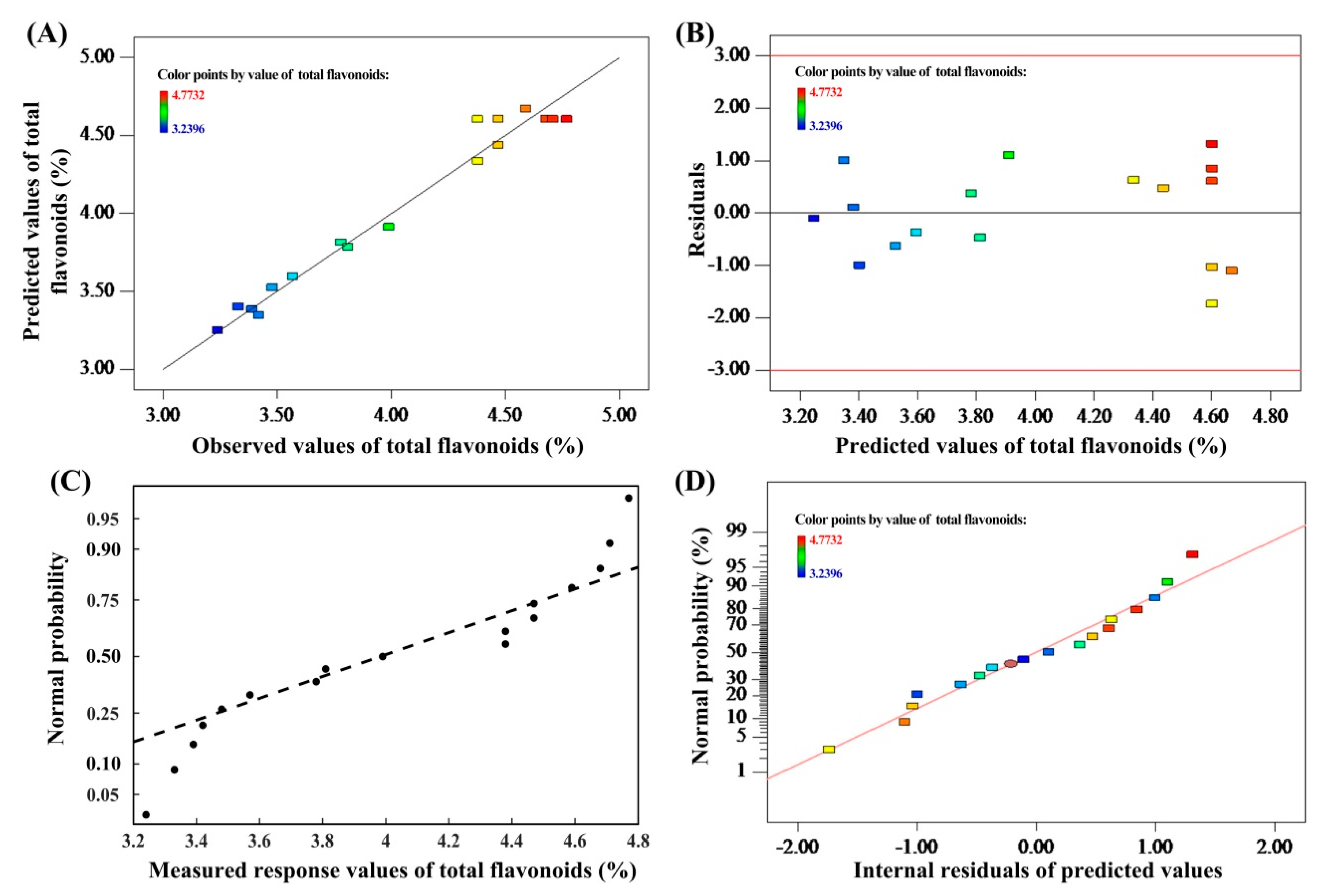
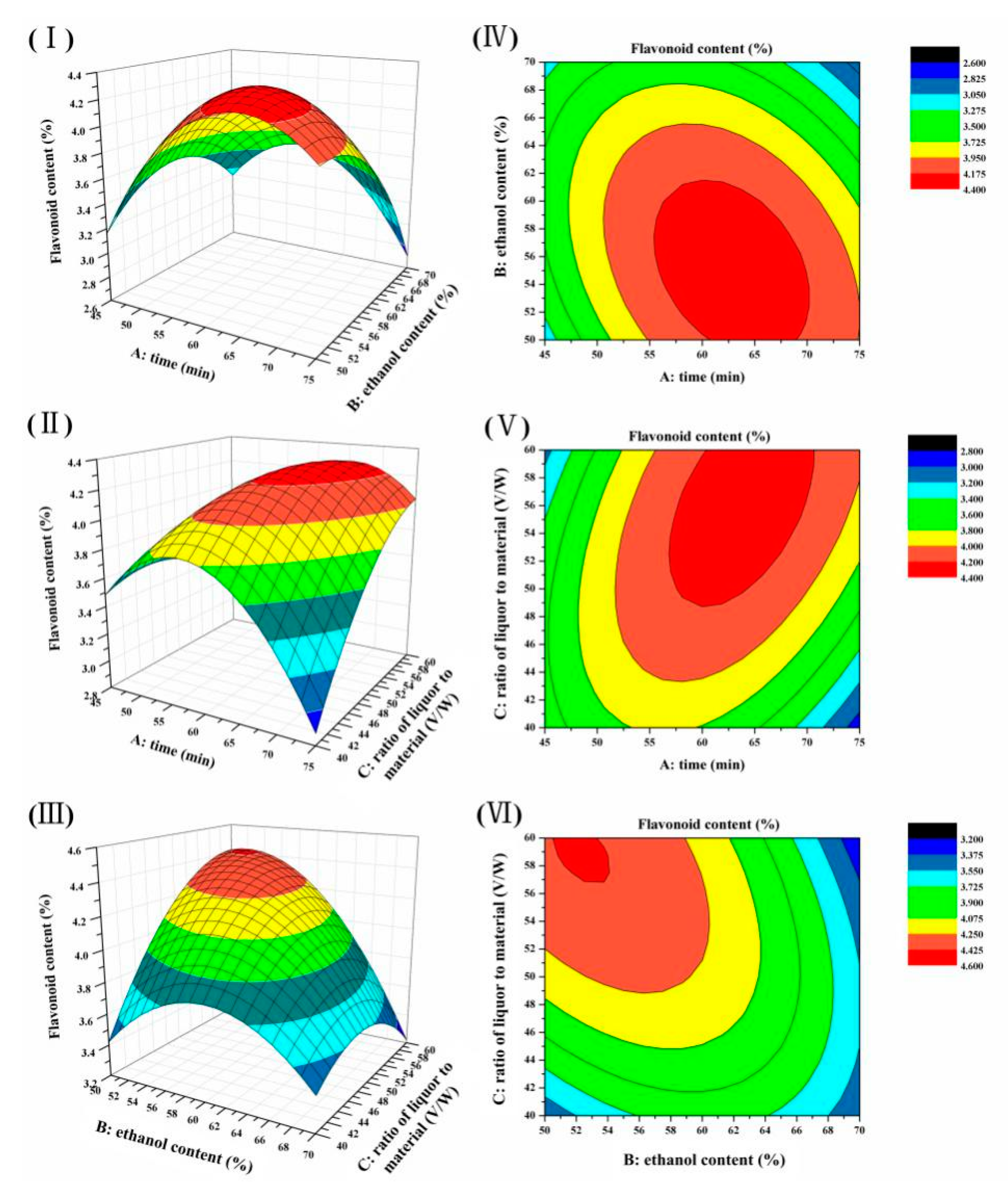
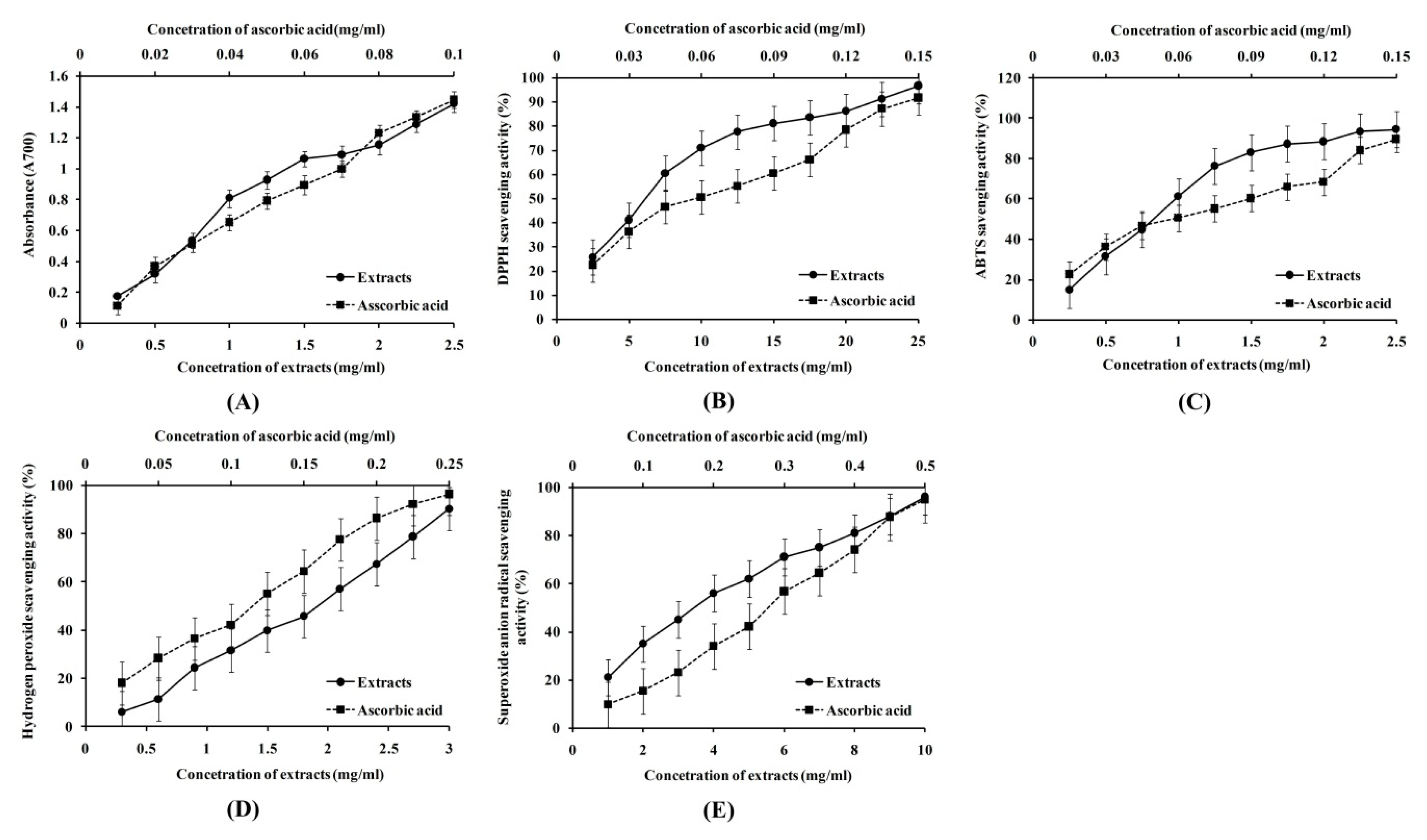
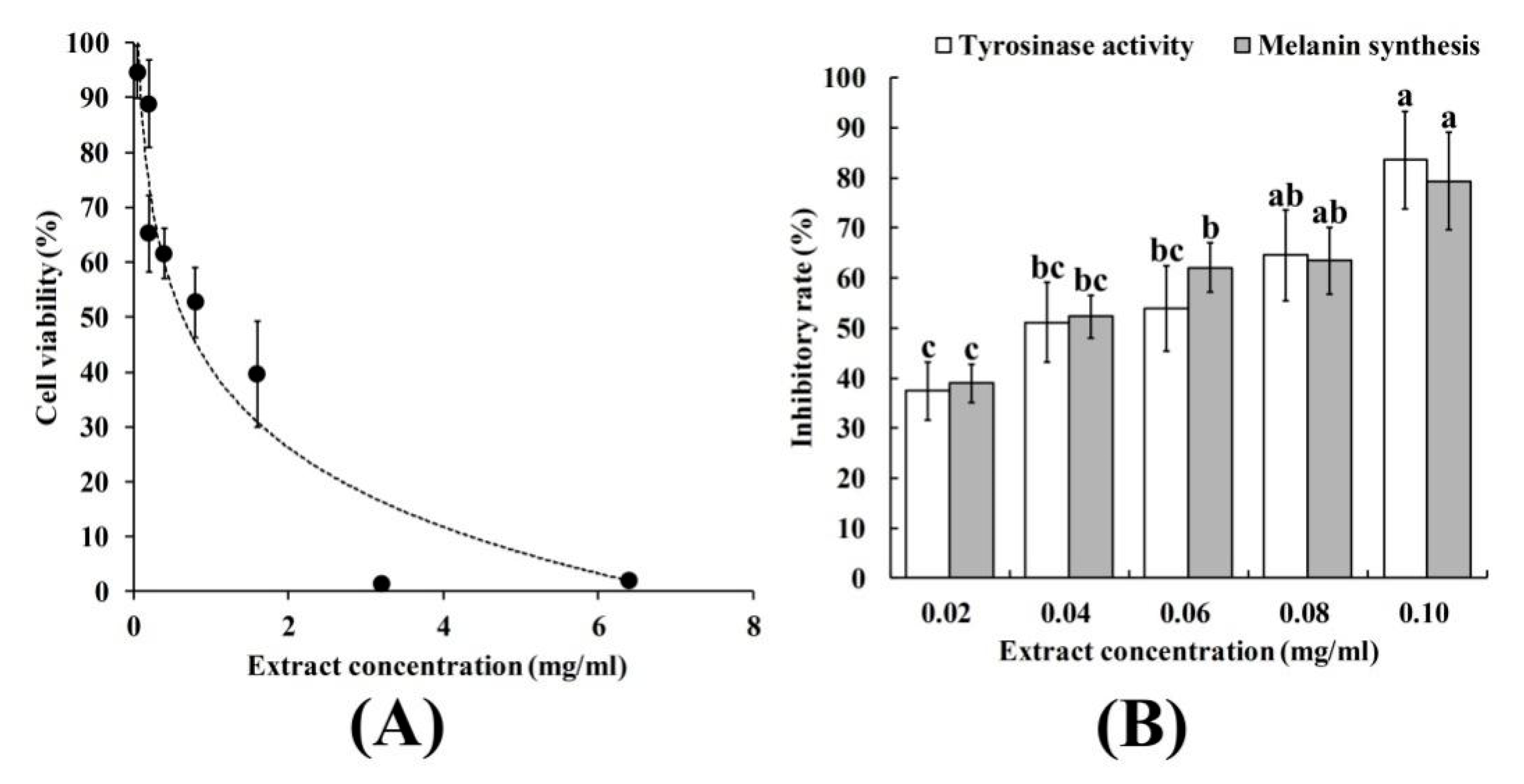

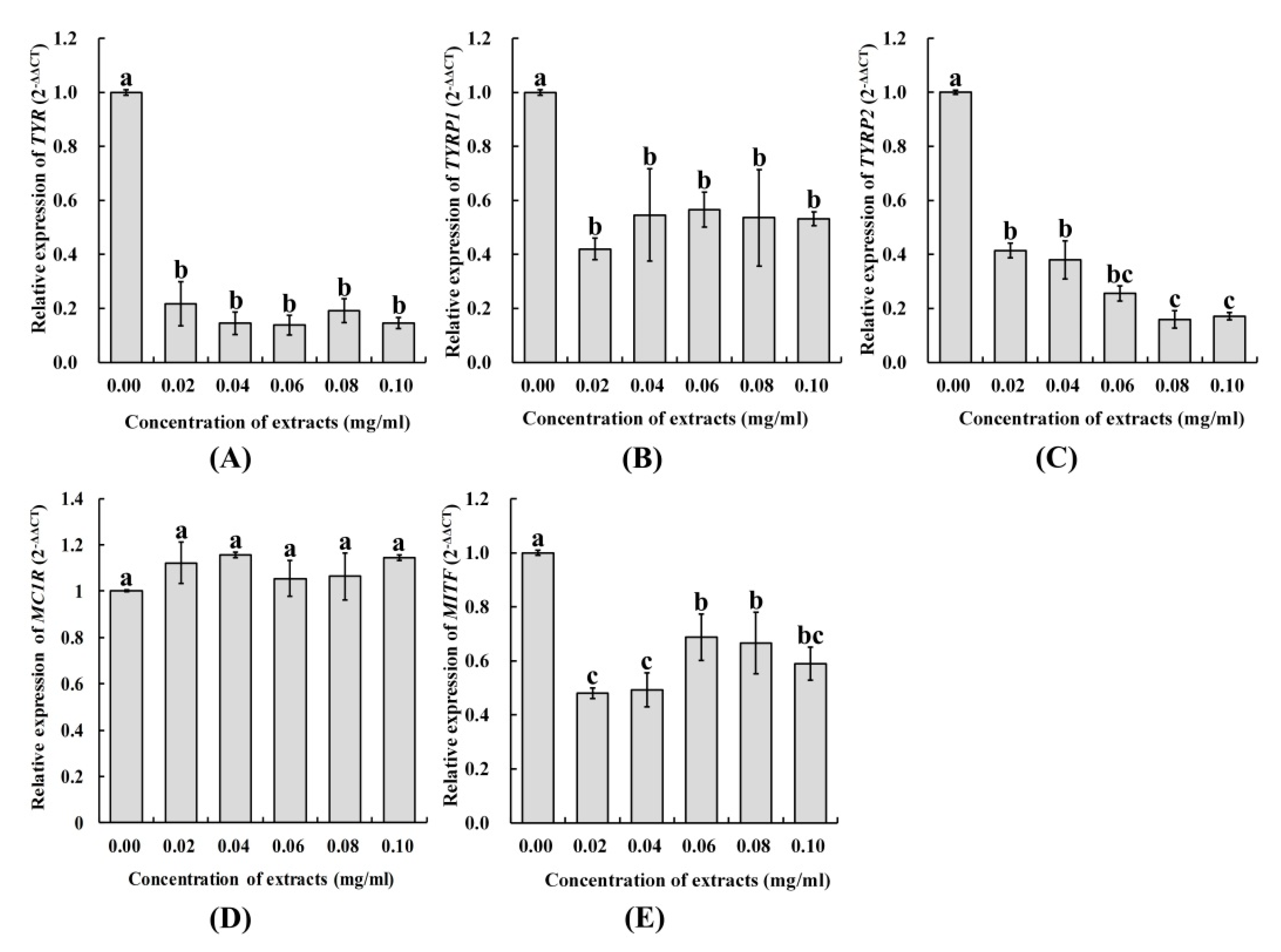
| Level | A: Extraction Time (min) | B: Ethanol Content (%) | C: Ratio of Liquor to Material (v/w) |
|---|---|---|---|
| −1 | 45 | 50 | 40 |
| 0 | 60 | 60 | 50 |
| 1 | 75 | 70 | 60 |
| Run Order | Variable | Total Flavonoids Y (%) | |||
|---|---|---|---|---|---|
| A | B | C | Observed | Predicted | |
| 1 | 0 | −1 | 1 | 4.59 | 4.42 |
| 2 | −1 | 0 | 1 | 3.42 | 3.1325 |
| 3 | 0 | −1 | −1 | 3.81 | 3.42 |
| 4 | 0 | 0 | 0 | 4.38 | 4.23 |
| 5 | 1 | −1 | 0 | 4.38 | 3.9425 |
| 6 | 0 | 0 | 0 | 4.68 | 4.23 |
| 7 | 1 | 1 | 0 | 3.24 | 2.7125 |
| 8 | 0 | 0 | 0 | 4.47 | 4.23 |
| 9 | 0 | 0 | 0 | 4.71 | 4.23 |
| 10 | 1 | 0 | 1 | 4.47 | 4.0325 |
| 11 | −1 | 0 | −1 | 3.78 | 3.4825 |
| 12 | 1 | 0 | −1 | 3.33 | 2.8825 |
| 13 | −1 | −1 | 0 | 3.39 | 3.1625 |
| 14 | −1 | 1 | 0 | 3.48 | 3.1925 |
| 15 | 0 | 0 | 0 | 4.77 | 4.23 |
| 16 | 0 | 1 | −1 | 3.99 | 3.42 |
| 17 | 0 | 1 | 1 | 3.57 | 3.22 |
| Source | Sum of Squares | DF | Mean Square | F Value | p-Value Prob > F |
|---|---|---|---|---|---|
| Model | 4.7575 | 9 | 0.5286 | 25.8661 | 0.0001 |
| A | 0.2278 | 1 | 0.2278 | 11.1474 | 0.0124 |
| B | 0.4465 | 1 | 0.4465 | 21.8489 | 0.0023 |
| C | 0.1624 | 1 | 0.1625 | 7.9490 | 0.0258 |
| AB | 0.3782 | 1 | 0.3782 | 18.5074 | 0.0036 |
| AC | 0.5625 | 1 | 0.5625 | 27.5244 | 0.0012 |
| BC | 0.3600 | 1 | 0.3600 | 17.6156 | 0.0041 |
| A2 | 1.5654 | 1 | 1.5655 | 76.6011 | <0.0001 |
| B2 | 0.5756 | 1 | 0.5756 | 28.1675 | 0.0011 |
| C2 | 0.2471 | 1 | 0.2471 | 12.0909 | 0.0103 |
| Residual | 0.1430 | 7 | 0.0204 | ||
| Lack of Fit | 0.0303 | 3 | 0.0101 | 0.3594 | 0.7866 |
| Pure Error | 0.1127 | 4 | 0.0282 | ||
| Cor Total | 4.9006 | 16 | |||
| DF = Degree of freedom | |||||
| Cor Total = Correlation Total | |||||
| Factor | Coefficient Estimate | Standard Error |
|---|---|---|
| Constant | 4.60 | 0.064 |
| A | 0.17 | 0.051 |
| B | −0.24 | 0.051 |
| C | 0.14 | 0.051 |
| AB | −0.31 | 0.071 |
| AC | 0.38 | 0.071 |
| BC | −0.30 | 0.071 |
| A2 | −0.61 | 0.070 |
| B2 | −0.37 | 0.070 |
| C2 | −0.24 | 0.070 |
| Extract | Ascorbic Acid | |||||
|---|---|---|---|---|---|---|
| EC50 (mg/mL) | p Value | Multiple R | EC50 (mg/mL) | p Value | Multiple R | |
| Ferrous Ion Reducing Power (A700) | 0.69 ± 0.027 | 0.0609 | 0.976 | 0.032 ± 0.004 | 0.129 | 0.995 |
| DPPH Scavenging Activity (%) | 6.13 ± 0.97 | 0.000494 | 0.935 | 0.063 ± 0.007 | 0.0000215 | 0.990 |
| ABTS Scavenging Activity (%) | 0.88 ± 0.013 | 0.0220 | 0.945 | 0.065 ± 0.010 | 0.0000418 | 0.984 |
| Hydrogen Peroxide Scavenging Activity (%) | 1.80 ± 0.147 | 0.00161 | 0.995 | 0.11 ± 0.033 | 0.00955 | 0.996 |
| Superoxide Anion Radical Scavenging Activity (%) | 3.84 ± 0.368 | 0.00000486 | 0.989 | 0.27 ± 0.061 | 0.0343 | 0.997 |
| Genes | RefSeq id | Sense Primer Sequence | Anti-Sense Primer Sequence |
|---|---|---|---|
| TYR | NM_000372.5 | 5′CACAGAGAGACGACTCTTGGTG3′ | 5′GCTGATGGTATGCTTTGCTAA3′ |
| TYRP1 | NM_000550.2 | 5′CCCCAGTCACCAACACAGAAA3′ | 5′CAGATAAGAAGCAGTCCCAAAA3′ |
| TYRP2 | NM_001129889.2 | 5′TATTAGGACCAGGACGCCC3′ | 5′CATCCAAGCTATCACAGACAGT3′ |
| MITF | NM_000248.3 | 5′GAGAACAGCAACGCGCAAAAG3′ | 5′CAGTGACACCGACGGGAGAAA3′ |
| MC1R | NM_002386.3 | 5′GTCAAAGAGGATGGACTAAATGATC3′ | 5′CAGGAGTGGGCGGAAAA3′ |
| β-actin | NM_001101.5 | 5′TTGCGTTACACCCTTTCTTG3′ | 5′TCACCTTCACCGTTCCAGT3′ |
© 2020 by the authors. Licensee MDPI, Basel, Switzerland. This article is an open access article distributed under the terms and conditions of the Creative Commons Attribution (CC BY) license (http://creativecommons.org/licenses/by/4.0/).
Share and Cite
Dai, C.-Y.; Liao, P.-R.; Zhao, M.-Z.; Gong, C.; Dang, Y.; Qu, Y.; Qiu, L.-S. Optimization of Ultrasonic Flavonoid Extraction from Saussurea involucrate, and the Ability of Flavonoids to Block Melanin Deposition in Human Melanocytes. Molecules 2020, 25, 313. https://doi.org/10.3390/molecules25020313
Dai C-Y, Liao P-R, Zhao M-Z, Gong C, Dang Y, Qu Y, Qiu L-S. Optimization of Ultrasonic Flavonoid Extraction from Saussurea involucrate, and the Ability of Flavonoids to Block Melanin Deposition in Human Melanocytes. Molecules. 2020; 25(2):313. https://doi.org/10.3390/molecules25020313
Chicago/Turabian StyleDai, Chun-Yan, Pei-Ran Liao, Ming-Zhuo Zhao, Chao Gong, Yue Dang, Yuan Qu, and Li-Sha Qiu. 2020. "Optimization of Ultrasonic Flavonoid Extraction from Saussurea involucrate, and the Ability of Flavonoids to Block Melanin Deposition in Human Melanocytes" Molecules 25, no. 2: 313. https://doi.org/10.3390/molecules25020313







